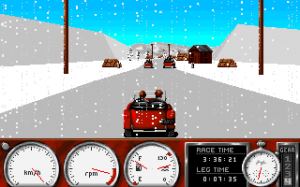1000 Miglia 
The Mille Miglia was an epic automotive endurance contest that started in the late 1920s. Back before safety issues were a big deal in the racing world, the Mille Miglia sent the most foolhardy drivers on thousand-mile open road race through the Italian countryside. It popped up around the same time as similar events like the Le Mans 24-hour race, but it was canceled when officials realized that the Mille Miglia was incredibly, incredibly dangerous.
Discontinued or not, the Mille Miglia has apparently ascended to the stuff of legends – at least enough to warrant a lavish game adaptation. 1000 Miglia treats the event with an intimate reverence, celebrating the Miglia’s first decade with an eye for historical accuracy. It is, in a sense, a documentary. Despite its good intentions and semi-educational purposes, 1000 Miglia just doesn’t have the technical strength to condense such a big race to a playable scale.
1000 Miglia lets you select from any of the event’s first seven annual races, as well as playing them all back-to-back as a lengthy series. Each lets you select from one of the driver teams that raced in the event, complete with the car they use in that race and guesstimated stats about their racing experience and favored roads. The Italian studio Simulmondo clearly poured their enthusiasm into these details. The racing structure shows a similar dedication to the actual race, encouraging you to take spare parts and supplies in the event of a breakdown. Driving takes place in accelerated real-time with each second equaling a minute on the road. The game hits all the right marks on the big-picture components.
Yet the driving itself is stunningly inept. The game immediately recalls OutRun and Rad Racer in its simplicity and visual style; turns are rarely too steep to warrant slow speeds or any simulation-level strategy. Given its realistic focus, 1000 Miglia offers plenty of opportunities for you to run off the road or end up in an accident from ramming another racer. These are good additions, especially since crashing usually costs you time rather knocking you out of the race. However, the gameplay dramatically worsens when you catch up with other cars on the road.
Simply put, 1000 Miglia is very fast, and the game cannot handle those speeds. Most objects – houses, trees, and other cars – only have a handful of messy graphics in varying sizes to simulate their approach from the distance. This effect looks pretty bad for things moving along the side of the road, but for cars on the road with you, it is almost impossible to discern their position, direction, and speed. The passing game most closely resembles one of those awful Tiger handheld games that could only display a few graphics at once. It is borderline impossible to navigate traffic with any reliability. At high enough speeds, everything on the screen flickers, resulting some a sort of weird hypnotic strobe that doesn’t convey movement so much as chaos.
A litany of similar flaws follows, such as the complete lack of in-race sound apart from a particularly grating engine noise.
I wanted to like 1000 Miglia for its scope and the care put into documenting a beloved racing event. The presentation is slick, and I enjoyed little touches like the skeuomorphic interface. The weather effects also add some appreciable variety and challenge to the courses. Neat details and historical honesty aside, the anemic driving game drains any of the fun to be had from tackling a long endurance race. With the proper technology on their side, Simulmondo could have made a very good game that canonized the Mille Miglia. But much like the actual Mille Miglia, that’s a difficult task with no room for the unready.


